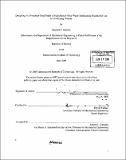Designing of a prototype heat-sealer to manufacture solar water sterilization pouches for use in developing nations
Author(s)
Quinlan, Saundra S
DownloadFull printable version (1.452Mb)
Other Contributors
Massachusetts Institute of Technology. Dept. of Mechanical Engineering.
Advisor
David Wallace.
Terms of use
Metadata
Show full item recordAbstract
Water purification proves to be a difficult task in many developing nations. The SODIS (SOlar water DISinfection) process is a method which improves the microbiological quality of water making it safer for drinking and cooking using the UV-A rays and heat from the sun. Even simple processes such as this, require components that are not easily attainable in many rural areas-in this case the recommended two-liter bottle. Amy Smith, an instructor in MIT's Edgerton Center, researched and tested the effectiveness of polypropylene collapsible water pouches in the SODIS process. Thus, a heat-sealing device that can be used in developing nations to manufacture collapsible water pouches is needed. This device is intended to allow individuals in developing countries to take advantage of the SODIS water purification process. The approximately 60 watt prototype of the heat-sealing device is powered by a 12-volt solar deep-cycle battery and is made of simple materials so that it can be used and maintained in a variety of developing nations. A 20 inch nickel chromium strip is used as the heating element and Teflon forms a barrier between the heating element and the material to be sealed. A 4-mil polypropylene sheet is the pouch material of choice. (cont.) It is placed on top of the Teflon strip, before a lever arm is lowered, the device is turned 'on' and the sheet is sealed via the heated nickel chromium strip. Although the alpha prototype presented in this thesis has a number of positive attributes, such as using easily accessible or shippable components and making use of available power sources and/or batteries, there are areas for improvement. Making the device more robust, user friendly and versatile and making the seal strength more consistent and accurate are important characteristics that should be considered when designing a beta prototype.
Description
Thesis (S.B.)--Massachusetts Institute of Technology, Dept. of Mechanical Engineering, 2005. Includes bibliographical references (leaf 23).
Date issued
2005Department
Massachusetts Institute of Technology. Department of Mechanical EngineeringPublisher
Massachusetts Institute of Technology
Keywords
Mechanical Engineering.